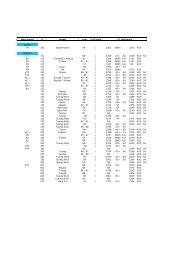catalogo generale general catalog catalogo generale general catalog
catalogo generale general catalog catalogo generale general catalog
catalogo generale general catalog catalogo generale general catalog
You also want an ePaper? Increase the reach of your titles
YUMPU automatically turns print PDFs into web optimized ePapers that Google loves.
Utilizzare gli attrezzi professionali per ribaditura catene<br />
cod. 805184 per catene passo 12,70 mm, cod. 805185<br />
per catene passo 15,875 mm e cod. 805186 per catene<br />
passo 19,05 mm (fig. 19); oppure I’attrezzo per ribaditura<br />
cod. 805188 per catene passo 15,875 mm (fig. 20), operando<br />
come segue:<br />
1 Tirare l’aletta “A” (fig. 19) che comanda l’apertura delle spine<br />
di fissaggio “B” (spingere verso I’esterno la rotella “C” se si<br />
utilizza l’attrezzo cod. 805188), inserire la catena nell’attrezzo<br />
di ribaditura in corrispondenza del primo dei due perni<br />
a ribadire e rilasciare I’aletta “A” (riportare nella sua posizione<br />
iniziale la rotella “C” dell’attrezzo cod. 805188). La catena sarà<br />
così correttamente inserita nell’attrezzo, tenuto in posizione<br />
dalle spina “B” (oppure dalla rotella “C”).<br />
2 Appoggiare il punzone “D” contro la testa del primo perno da<br />
ribadire.<br />
3 Con l’ausilio di un martello colpire con forza l’estremità del<br />
punzone “D” per deformare la testa del perno da ribadire.<br />
4 Ruotare il punzone “D” di circa 45° e ripetere I’operazione “3”.<br />
5 Ripetere altre due volte l’operazione “4”, ruotando ogni volta<br />
il punzone “D” di ulteriori 45°.<br />
6 Liberare la catena tirando l’aletta “A” che comanda l’apertura<br />
delle spine di fissaggio “B” (spingere verso I’esterno la<br />
rotella “C” dell’attrezzo cod. 805188) e riprendere il ciclo di<br />
operazioni sul secondo dei due perni da ribadire.<br />
7 Controllare che la maglia di chiusura articoli perfettamente e<br />
che gli O-Ring siano integri e ben posizionati.<br />
Dopo la chiusura procedere al tensionamento della catena<br />
ed al serraggio della ruota posteriore come spiegato nel<br />
capitolo precedente.<br />
26<br />
RIBADITURA RIVETING<br />
ATTENZIONE WARNING<br />
Verificare accuratamente che la catena in esercizio non urti<br />
parti metalliche del veicolo, quali carter motore, forcellone,<br />
guidacatena o tenditori.<br />
Use Regina professional Rivet Tools P/N 805184 for 12,70 mm<br />
(1/2”) pitch chains, P/N 805185 for 15,875 mm (5/8”) pitch<br />
chains, P/N 805186 for 19,05 mm (3/4”) pitch chains (fig. 19),<br />
or P/N 805188, only available for 15,875 mm (5/8”) pitch chains<br />
(fig. 20), operating as follows:<br />
1 Pull the plate “A” (fig. 19) to open the positioning rods “B” (push<br />
round shield “C” if using P/N 805188), and insert the chain into<br />
the tool. The chain should be correctly inserted into the tool and<br />
kept in place by rods “B” or by round shield “C”.<br />
2 Slide punch “D” to contact the head of the pin to be riveted.<br />
3 With a hammer, give a sharp blow to punch “D” to deform the<br />
head of the rivet pin.<br />
4 Rotate punch “D” approx. 45° and repeat operation “3”.<br />
5 Repeat operation “4” two more times, each time rotating punch<br />
“D” approx 45°.<br />
6 Release the chain by retracting plate “A” to open the positioning<br />
rods “B” (using Rivet Tool P/N 805188, push round shield “C” to<br />
the side) and repear the operation cycle on the second pin to be<br />
riveted.<br />
7<br />
Check for smooth flexing of the link and that the O-Rings are<br />
correctly positioned and not damaged or cut.<br />
After riveting, the chain must be correctly tensioned and the<br />
rear wheel axle must be tightened as indicated in the previous<br />
paragraph.<br />
Carefully check that the chain, when in motion, does not touch<br />
any metal part of the vehicle, such as the engine casting, the<br />
swing arm, chain guides, tensioners or other parts.<br />
FIG. 19 FIG. 20



